We all know how to ride a motorcycle but just knowing how is not enough to protect ourselves on the road. Riding a motorcycle on the road is a very risky task, which some of us never understand clearly. But the truth is there is no shame in improving your skills and learning a few techniques that can really improve your ability to ride more safely and comfortably.
You must learn about Gumperson’s Law, which stated simply is, “The contradiction of a welcome probability will assert itself whenever such an event is likely to be the most frustrating.” Or another version: The outcome of a given desired probability will be the inverse of the degree of desirability.
In even simpler language, it means, the worst possible thing that can happen, will happen – but only at the worst possible time.
The point is, you must always prepare for the worst when you are riding on the road. To reduce such chances of any mishaps, you must learn the science behind riding a motorcycle with more comfort and safety.
So, follow the fundamental premise: Ride as if you’re invisible.
Controls & Adjustments
Well, it is simple to understand that if you are planning to go for a ride, you must test your bike first. Make sure to check all the control adjustments to see if they are ready to respond and are working well. It will give you confidence and the ability to ride your bike accordingly. This way you can do something against Gumperson’s Law by adjusting the controls of your bike.
Handlebars
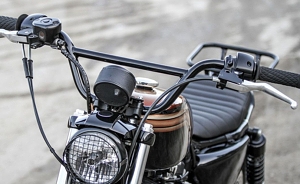
Handlebars vary with motorcycles. If you notice, motocross bikes have wide and flat bars that give the riders a broad grip to control the bike. However, the racers have low bars. This is because to attain higher speeds, the rider needs to crouch low in a horizontal direction. This riding style needs low flat bars. When handlebars come attached to a bike, they have a standard size, which either suits you or not. So, it is important to make some adjustments in the handlebar to maintain your ideal position while riding.
You can easily adjust the handlebars accordingly. All you have to do is loosen the clampdown bolts that are located in the center of the bar and rotate the bars to change the position. You can select your required position and tighten the bolts after your selection. Just make sure, you don’t rotate the bar carelessly; otherwise, the wires that are coming from the center of the bars could be damaged. If you are intending to change the handlebars make sure to purchase the ideal length cable to position the control levers at the end of the bars.
Control Levers
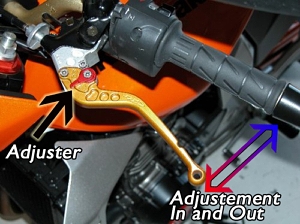
It is important to have full control over the brake and clutch levers. So, you can adjust the control levers to the position where you feel most comfortable and they are close enough to reach when required. Many people who have small hands have a problem reaching both the clutch and brake levers. So, if you also have small hands and have trouble reaching the control levers then you can do a little trick of using a faucet washer to adjust the levers closer to the handlebar.
You can buy a faucet washer from any hardware store and slip it over the exposed inner cable. But I need to remind you that these washers tend to wear out so make sure you purchase enough to use anytime when one of them wears out.
Shifter
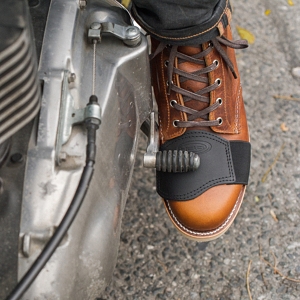
If you need to adjust your shifter then you can make two types of adjustments to a shifter. But, make sure you avoid extremes; otherwise, you may damage your shifter.
If your shifter needs a position adjustment, then make sure it is not too high or low because in both cases, you will face a problem. If your shifter is positioned so high that your foot leaves the peg to reach out to change the gear, then it can affect the bike’s stability. On the other hand, if the shifter is adjusted too low, then it will be in the way of other obstacles and may cause some serious problems like damaging the transmission in the event of a crash or causing a strong vibration.
Now, if you need an adjustment in length, then remember, “Don’t extend or shorten a shifter by more than one-third of its original length.”
A small shifter can damage your motorcycle boots and the bike will be difficult to operate. And an extended shifter will be easy to damage since you will have a mechanical advantage.
Rear Brake
Follow the same rule of one-third of the original length in the adjustment of the rear brake pedal. Just make sure to check the pedal before installing it. You can also cover it with a reinforced rubber cover to make sure it won’t bend or break.
Tire Pressure
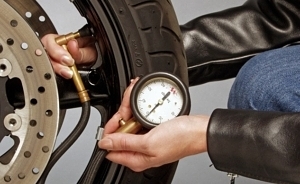
Tire pressure may not seem like a crucial adjustment to you. But it is. If you give a little attention to the tire pressure, it is the most easily adjusted variable of your motorcycle. So, if you are a daily rider, then don’t forget to check the air in your tires regularly at gas stations. If you are riding with a passenger, don’t forget to put a little extra air in your tires and remove it after dropping off your passenger.
Clothing & Equipment
Clothing and equipment are also very important for a motorcycle rider to ride safely on the road. In fact, every sport or extreme activity requires suitable protective equipment and motorcycle riding is no different than other sports activities. Full protective riding equipment means a safety helmet that is certified with safety standards, a full sleeve motorcycle jacket, over the ankle boots, and motorcycle gloves. Here we study all of them, one by one.
Helmet
A helmet is not a “cure-all” for motorcycle safety, but it can help you to protect your head, face, and even can save your life. If you wear a helmet combined with the rest of the motorcycle protective gear, it can reduce severe injuries during an accident. Wearing a helmet shows that motorcyclists are responsible people; plus wearing a helmet no matter what other people say, is a projection of your attitude towards riding. So, let’s discuss a few things about the helmet.
There are three basic styles of helmets and each has its advantages and disadvantages.
Half-Face Helmet
Advantages: Half helmets are lightweight and compact. They provide excellent ventilation, cooling qualities to the rider, better comfort level, and protection to the top part of your head.
Disadvantages: Half-Face helmets have no chin bar to protect your chin and no slot to attach a face shield to the front. They can only be comfortable when used with slower bikes such as cruisers.
Open-Face Helmet
Advantages: Open-face helmets have a face shield to block direct air. It provides excellent ventilation for the head area of the rider, and is also very comfortable, while at the same time protecting the rider’s face and rear neck areas.
Disadvantages: Open-Face helmets are little heavy and have no chin bar to protect the lower face area and neck. They are safer than open-face helmets but not as safe as full-face helmets.
Full-Face Helmet
Advantages: Full-face helmets provide the ultimate protection for the rider, have a higher comfort level and provides safety from obstacles and dust particles, etc.
Disadvantages: Full-face helmets have limited lateral vision, less ventilation compared to open face and half helmets, and they limit the neck movement, as well.
So, you need to figure out which helmet will be suitable for you and choose a safety helmet of the right size to wear while riding. After all, the fit of the helmet is also one of the main concerns here; otherwise, if it is too loose or too tight, the helmet will distract you while riding, which could cause a mishap. To learn about the Best Motorcycle Helmets and “How to Choose the Right Size Helmet,” you can visit a nearby helmet store or check out online stores to explore safety helmets.
Eye Protection
Eye protection is also a very important point to concern yourself about while riding a motorcycle on the road. However, for many people, it is just a personal preference.
Well, I think that is not entirely false. Anyways, you must get whatever seems to enable you to see the best and be comfortable.
Whether you wear sunglasses, bubble shields, or flat face shields.
Motorcycle Gloves
Motorcycle Gloves are best known for providing abrasion protection and weather protection. So, if you travel in cold weather then you need insulated mittens or full-grain large leather gloves. But if you are riding in the hot summer, then you need modern, light, fabric gloves that also provide ventilation to your hands.
There are different types of motorcycle gloves that help you in different riding conditions.
Motorcycle Boots
Anyone who has had an accident resulting in an ankle or leg injury will always emphasize wearing motorcycle boots to you. So, if someone says such a thing to you, heed what they have to say.
Motorcycle boots provide crash and abrasion protection to your legs and ankles in the case of an accident. Choosing the right motorcycle boots is not an easy task. But you must have a decent pair of motorcycle boots that match your riding style and provides protection to your foot and ankle in case of any mishap.
Motorcycle Jacket
Whether you believe it or not, a Motorcycle Jacket is a very important piece of protective riding gear that also provides weather protection to the rider in harsh weather. Nowadays, many motorcycle jackets come with additional armor padding in chest, elbows, and shoulder areas. These jackets are designed for extreme conditions, off-road racers, GP racers, and for riding during the hot summer. You can also choose the classic leather jackets, which are highly known for their natural protection and now these leather jackets are designed and available in bright colors that ensure your visibility.
So, if you are looking for a motorcycle jacket, make sure you choose the right fit.
Pre-ride Check List
- Gas Level and Quantity
- Oil Level
- Cable Adjustment and Condition
- Brake Adjustment
- Chain Adjustment and Condition
- Tire Condition and Inflation
- Lights and Horn
- General (Frame, oil leaks, etc.)
This is the pre-ride checklist. You must check all these things before going on a ride. And by checking, we mean examine these checkpoints on your bike before you start the engine of your bike. Once you have been through this examination and have found no problems, you are ready to start your engine.
Warm-up Your Motorcycle Engine
Motorcycle engines, especially older engines take some time to warm up. You just can’t push the button and go for a ride. The motorcycle needs some time to reach the proper operating temperature and for lubricants to reach their destined workstations. So, you must give your bike a couple of minutes running time to warm up before you go for a ride.
Getting Underway
Have you ever noticed, when you start your bike and put it in first gear to move forward, you hear a clunking sound? That sound comes from a freshly started motorcycle and it is because the clutch plates are not completely free from each other due to oil residue bonding them together. To get rid of this problem, you can roll the bike forward as you shift to the first gear.
But, don’t do it harshly. It could harm the transmission.
Braking
A motorcycle has front and rear brakes. From which, the front brake contributes to 75 percent of the braking load; however, the rear brake contributes only 25 percent. But, like all other professionals, we also suggest that you use the rear brake first to slow down. But if the situation demands instant stopping, then you must use both brakes simultaneously. There are some disadvantages of using both brakes to stop instantly – 1. The bike will be unstable, and 2. Hard braking compresses the front forks resulting in the loaded weight shifting to the front suspension.
So, put yourself in such a situation where you need to use both brakes. Try to keep your bike vertical while using the brakes more effectively.
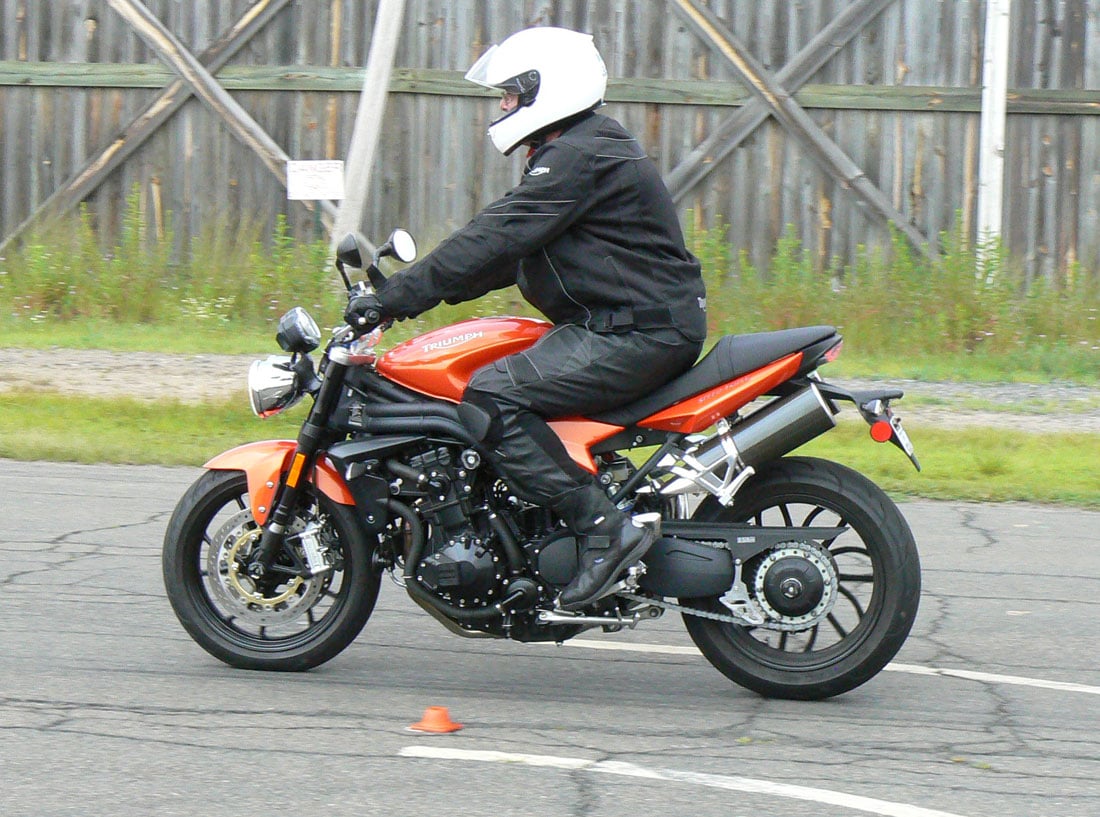
Motorcycle Turning
It is an important question and we all need the answer on how to safely turn our motorcycle on sharp turns.
Well, ‘practice makes perfect’. And to practice overcoming a turning problem, you must re-evaluate and plan every turn you take, whether it’s a sharp turn, a smooth curve, or a rough bend on a bumpy road. In a case study, it was discovered that right-handed riders are more comfortable taking a left turn; however, left-handed riders are skillful in taking a right turn more comfortably.
So, you must try to develop your turning skills to turn on your weakest side more comfortably. Once you learn to turn both sides perfectly then you can avoid many mishaps. To practice such skills, you should give some thought to your turning techniques. Here, we will show you a few techniques that you can adopt, to learn how to turn your motorcycles in both directions and to perfect the turns by practicing.
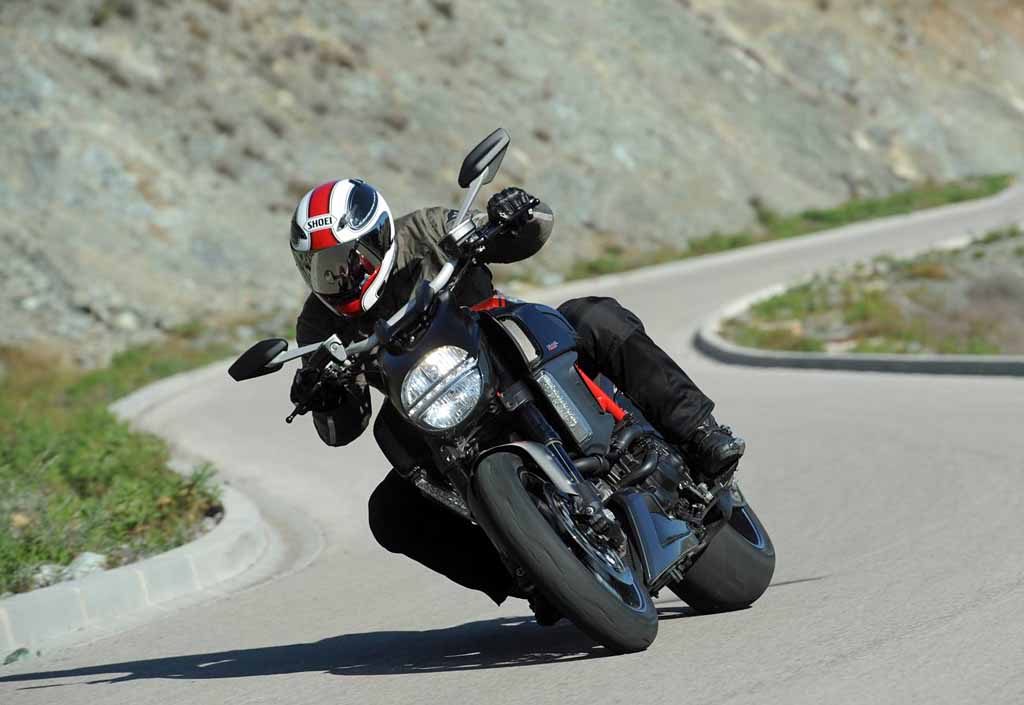
Turning Techniques
- First, use the brake before taking any turn. Make sure your bike is vertical when you use the brake; otherwise, if you use the brake when your bike is in a leaning position, then the wheel will not be rotating which is required to take the turn perfectly and safely.
- Always avoid potholes, water, gravel, oil, or anything else on the road. These are considered as obstacles while taking a turn.
- Consider some posture elements to take the perfect turn like – Open your hips to the turn and use your knee pressed against the outside of the tank.
Traffic
Sharing the road with big trucks, SUVs, and cars is not an easy task. Especially when most people are in such a hurry!
When you’re on the road, you’re surrounded by many vehicles, which increases the chances of a crash if you don’t ride carefully. Don’t forget Gumperson’s Law as we talked about in Part 1. On the road, we should use a practical approach because a motorcycle is no match for big cars and trucks. It doesn’t provide any natural protection to the rider as a car does. If you are in a car, a minor accident would be a “fender bender” but if you are on a motorcycle, then your injuries would be much more serious than the person who was sitting in a car. So, use your extra visibility and keep your mind wide open. Always, check the rear-view mirror from time-to-time for passing vehicles.
Make sure, you always keep a safe distance from the vehicle in front of you, so that if the person sitting in the vehicle in front of you uses the brake to stop instantly then you will have time to stop your motorcycle as well. Make sure you are riding in your lane, otherwise, you may face some overtaking vehicles or huge pollution which can distract you from your riding.
Group Riding Techniques PDF Guide
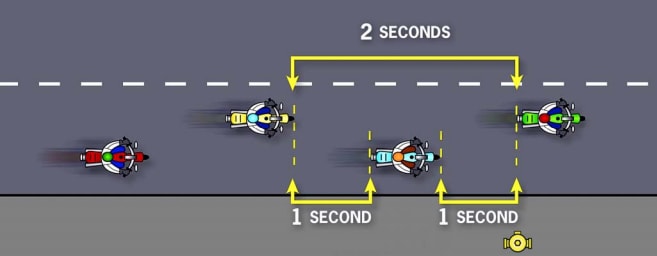
A staggered formation is a perfect way to ride in groups. This formation gives each rider sufficient space and time to react to hazards and to examine the situation in front of them.
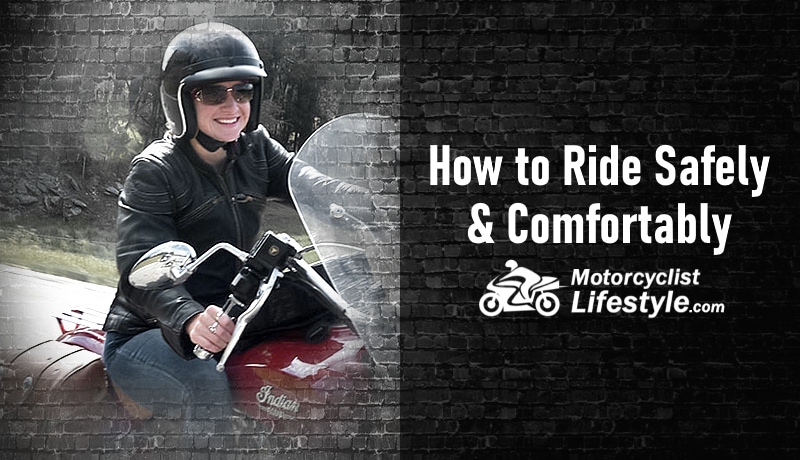
Leave a Reply